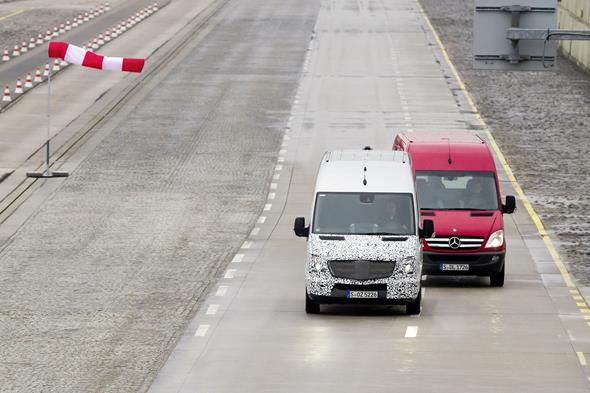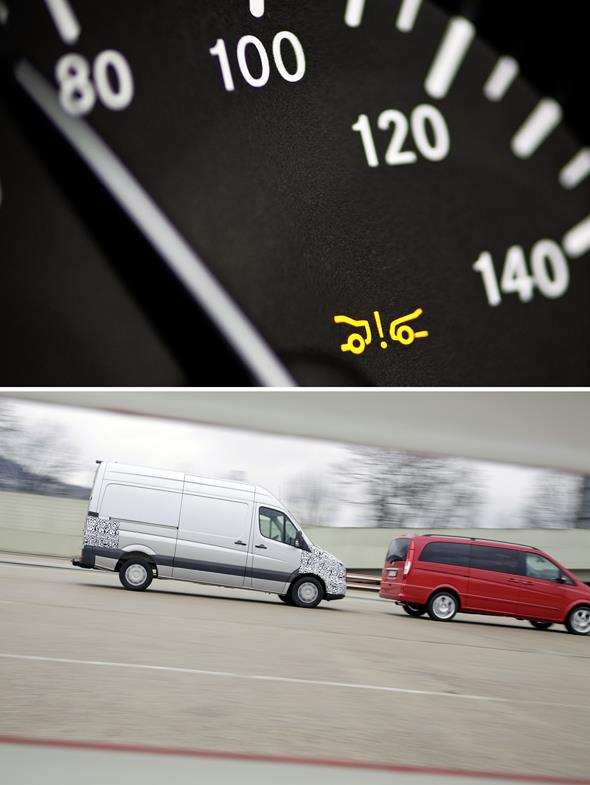Safety for vans


Mercedes-Benz Vans: five new assistance systems bring even higher levels of safety to Vans with the Star
- Mercedes-Benz Vans extends its leadership in innovation
- Five new assistance systems – three world premieres
Stuttgart/Boxberg – With five new assistance and safety systems, Mercedes-Benz Vans is continuing to extend its role as an innovation leader among van manufacturers. The systems include three world premieres for this category of vehicle: Crosswind Assist, Collision Prevention Assist and Blind Spot Assist.
They were presented yesterday for the first time by the Stuttgart-based automotive manufacturer as part of a Mercedes-Benz Vans TecForum held at the Boxberg testing ground. The new systems are expected to be introduced in vans with the star in just a few months.
Five new assistance systems – three world premieres
Preventing accidents from happening in the first place rather than mitigating the consequences afterwards – active safety is paramount for Mercedes-Benz Vans. The five new assistance systems will increase the high level of safety of Mercedes-Benz Vans even further.
Crosswind Assist keeps a van safely on course when the wind is gusting strongly. The Collision Prevention Assist alerts the driver if the vehicle gets too close to other moving vehicles on the road ahead or to the end of a queue of traffic, while the Blind Spot Assist warns a driver that is about to change lane that vehicles in the next lane are dangerously close.
All three systems are celebrating their world premieres in the van class. Also new are the Lane Keeping Assist and Highbeam Assist.
Volker Mornhinweg, Head of Mercedes-Benz Vans: “When it comes to safety, we have always enjoyed a pioneering role with our vehicles and are now launching a new era in assistance and safety systems for vans. These systems will support the driver and help to avoid accidents, thereby also ensuring the maximum availability of our vans.”

Mercedes-Benz Vans has a long tradition of taking a pioneering role in relation to assistance and safety systems: it was the first brand in this sector to introduce Antilock Brake System ABS in its flagship Sprinter model as early as 1995. This was followed by the Electronic Stability Program ESP in 2002.
Further trailblazing advances from Mercedes-Benz Vans came in 2006 with the further development of the system to create ADAPTIVE ESP. This system takes the actual weight of the vehicle and its centre of gravity into account when calculating the control characteristics. Both generations of ESP have led to drastic reductions in accident numbers.
Generally speaking, accidents involving vans happen in very similar ways to those involving passenger cars. This has been evidenced by a recent research report undertaken by, amongst others, accident researchers working on behalf of the insurance companies, and Germany’s Federal Highway Research Institute (BASt).
When it came to looking at the mileage, the researchers even registered a lower accident risk for vans than for passenger cars.

In developing its new assistance systems, Mercedes-Benz Vans was able to benefit from the unique expertise available in the company’s Group Research division as well as from the experience gained by its passenger car and commercial vehicle units.
Dr Sascha Paasche, Head of Development at Mercedes-Benz Vans: “We are fortunate in being able to benefit from a very special network and a transfer of knowledge within the Daimler Group. This is just one more reason why we are at the top when it comes to safety engineering.”





